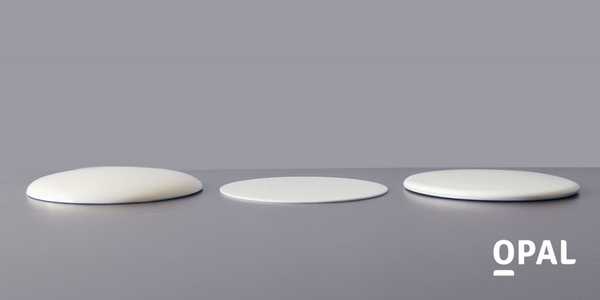
The thickness of the tombstone porcelain
Types of tombstone porcelain for a monument - different thicknesses
Currently there are three types of tombstone porcelain that are the most popular on the market: standard, convex (imitating old tiles) and thin tiles only 1 mm thick! How are these tombstones different? Which porcelain should be chosen for a monument?
Photo: Types of porcelain, from the left: convex, thin, standard. You can see the differences in shape and color.
Convex photoceramics
Convex porcelain is produced in Poland by the traditional method of pouring liquid porcelain into plaster molds. They do not have an exact, constant size because the plaster molds that are used many times wear out and change their size. With convex porcelain, a slight discrepancy in dimensions is a natural thing that should be taken into account when deciding to order this product.
These porcelain are finished with a harder layer of glaze, which gives the photos a unique character and the effect of a slight softening of the figure.
Such porcelain is most often used for the renovation of an old monument, where some photos are well preserved and we only replace selected ones. Convex porcelain is used mainly because of its visual similarity to old, well-preserved porcelain - they do not differ from them in shape and thickness.
In addition, the color of convex porcelain is more similar to the older, slightly cream tiles. This is not a disadvantage of convex plates, but their characteristic feature. Although some people may not like the warmer color of convex tiles, for many people it is the shade that has all the charm of this type of photoceramics.
Photo: Convex photoceramics
Photo: Close-up on convex photoceramics. We can observe spherical distortion and the softness of facial features.
Standard photoceramics
Standard porcelain is produced using modern technologies with the use of pressed molds. They are slightly thinner and flatter than convex tiles. The method of producing standard porcelain guarantees the repeatability of the tiles and that the dimensions will be maintained. In the case of this product, there is no question of uncertain shape or size. The colors and lines of photos on standard porcelain are clearer than on convex porcelain. The standard tile itself is whiter than convex porcelain, so the end result of the photoceramics will also differ in this respect. Flat porcelain guarantees a better reproduction of the photograph, as there is no spherical distortion on them. Standard porcelain will appeal to most customers. It is the most classic solution that fits most tombstones.
Photo: Standard photoceramics
Photo: Close-up on standard photoceramics. The facial features are clearer than on convex porcelain. There is no spherical distortion.
Thin photoceramics
Thin porcelain is the newest product available on the tombstone photography market. They are made of very durable technical porcelain. This novelty allows even greater freedom in the arrangement of the monument due to the minimum thickness of the photo. Despite the fact that these porcelain are only 1 mm thick, even the dark surface of the monument does not show through. Thin porcelain are resistant to breaking and tearing even at changing temperatures. Thin porcelain will fit into the aesthetics of many customers, especially recommended for tombstones with a slightly more modern character. Thin porcelain should be mounted with double-sided tape in order to minimize the protrusion of the porcelain from the monument. Porcelain available on the site www.opal.lublin.pl are delivered to the customer with the tape already stuck on, ready for installation.
Photo: Thin photoceramics
Photo: Close-up of thin photoceramics.
Photo: From the left: standard photoceramics (top) and thin photoceramics (bottom), thin photoceramics on a stand, thin photoceramics in profile
When choosing the type of porcelain for a monument, one should be guided primarily by the overall shape of the tombstone. If we only need to restore old porcelain, and the monument has other older-generation tiles, it is worth choosing convex porcelain. In most cases, however, standard porcelain will be suitable, which gives us a guarantee of durability and the most classic visual effect. Modern monuments go well with thin porcelain, which we recommend to customers who appreciate the modern look of a tombstone.









